 | Mammillaria Society Forum
Discussion Forum about Mammillaria, Coryphantha and Escobaria
|
|
| | More plants in habitat |  |
| | | Author | Message |
|---|
Chris43
Moderator


Number of posts : 1872
Age : 81
Location : Chinnor, UK
Registration date : 2008-07-16
 |  Subject: More plants in habitat Subject: More plants in habitat  Mon May 09, 2011 11:58 am Mon May 09, 2011 11:58 am | |
| This is a plant that I saw during my April 2010 trip. 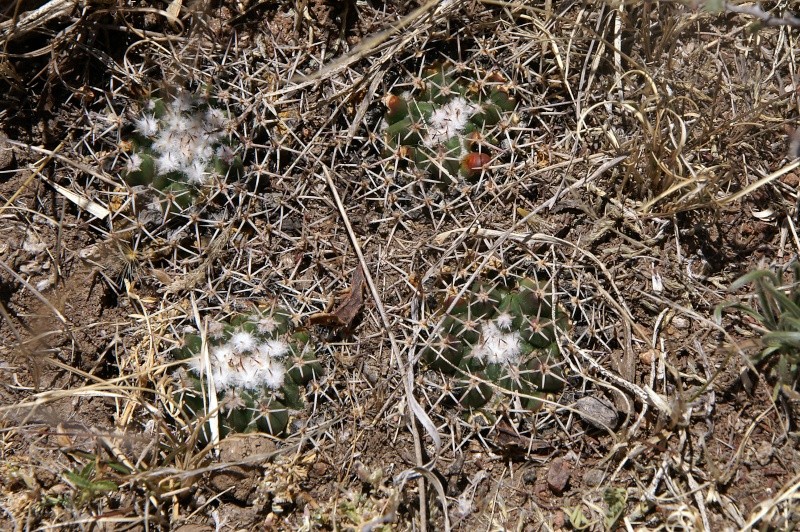 As you can see it is, in this case anyway, a rather flattened plant, with thick tubercles, roughly 5 radial spines and a single central spine, somewhat upright in position. I took this photo on an area of open ground, not on rocks, just to the west of the village of San Francisco de los Organos, after turning off the MEX-45. I had the plant down initially as Mammillaria heyderi ssp. gummifera, but I am not so sure, especially having seen what I consider to be the proper gummifera later on, and in flower. It has far too few radial spines to be even close to the description of gummifera. It does come close to the description of M. heyderi ssp meiacantha, but from what I understand of this subspecies' distribution, where I took this photo is a good way off, and never reported from Zacatecas or Durango (the border of which was not too far away). Suggestions would be very helpful indeed.
_________________
Chris43, moderator
| |
|   | | Guest
Guest
 |  Subject: Re: More plants in habitat Subject: Re: More plants in habitat  Mon May 09, 2011 5:25 pm Mon May 09, 2011 5:25 pm | |
| Hi Chris, you're shure that it is a Mammillaria? It looks quite similar to plant which MAURICE showed in CSSA 5/1996 as WAF2317. The habitat is about 70km northeast near Miguel Auza. He called it M.wagneriana and he said this form looks like the original illustration from BOEDEKER. It has the same big tubercles. I know M.wagneriana from further south looks different... M.meiacantha (or what I think it is) we found a little bit farther north. There are much more tubercles. Please compare WTH537 or a picture from us.  |
|   | | Guest
Guest
 |  Subject: Re: More plants in habitat Subject: Re: More plants in habitat  Tue May 10, 2011 3:48 pm Tue May 10, 2011 3:48 pm | |
| Allow me to ask a stupid question because it was my first impression when I saw this. Are you sure it is a Mammillaria? The tubercles look like those of a Coryphantha. Even though no groove is visible sometimes it is not always visible |
|   | | Chris43
Moderator


Number of posts : 1872
Age : 81
Location : Chinnor, UK
Registration date : 2008-07-16
 |  Subject: Re: More plants in habitat Subject: Re: More plants in habitat  Tue May 10, 2011 6:28 pm Tue May 10, 2011 6:28 pm | |
| That's not a stupid question, Amante, and Robby too. I wondered about a Coryphantha or even a Thelocactus before coming back to Mammillaria, largely because I couldn't place it in either of those first two genera.
Based on the distribution maps and the descriptions and narrative in Luthy and Dicht, the most likely Coryphantha candidates are ottonis and poselgeriana. But, even allowing for a range of variation, I can't equate either of those with the photo. I had already seen specimens of ottonis and they were nothing like these. C. poselgeriana is a different shaped plant altogether. I wish I had taken some more photos, but it was at the end of our time on that site and I really was in a hurry just to take a shot.
As for Thelocactus, T. hexaedrophorus comes from Zacatecas and that is the only species that does acc. to the New Cactus Lexicon. This seems to be the western extent of its range, but this species does have even broader tubercles and a short groove as far as I can see.
So....hmmmm....??
_________________
Chris43, moderator
| |
|   | | jfabiao

Number of posts : 539
Age : 60
Location : Lisbon, Portugal
Registration date : 2010-05-25
 |  Subject: Re: More plants in habitat Subject: Re: More plants in habitat  Tue May 10, 2011 9:52 pm Tue May 10, 2011 9:52 pm | |
| Fascinating! I've never been to Mexico, nor do I have any idea of the distribution of the cactus species, and your photo is a wonderfull puzzle, Chris. The plants have something of Thelocactus to them, they remind me of a short spined T. matudae. But the wooly tops are more reminiscent of Coryphantha. | |
|   | | Guest
Guest
 |  Subject: Re: More plants in habitat Subject: Re: More plants in habitat  Wed May 11, 2011 7:09 am Wed May 11, 2011 7:09 am | |
| I can assure you it is not Thelocactus hexaedrophorus (lloydii).I have seen this species near Fresnillo and it is a very different species. Here is the picture taken in 1998 and produced from slide photos.
https://i.servimg.com/u/f22/13/02/58/84/scan0010.jpg
and neither is M. wagneriana which is shown below at Mesa Grande, Aguascalientes
https://i.servimg.com/u/f22/13/02/58/84/dscf4210.jpg
At least we can rule these out.
|
|   | | Chris43
Moderator


Number of posts : 1872
Age : 81
Location : Chinnor, UK
Registration date : 2008-07-16
 |  Subject: Re: More plants in habitat Subject: Re: More plants in habitat  Wed May 11, 2011 10:16 am Wed May 11, 2011 10:16 am | |
| I agree with you, it isn't wagneriana. To help in the puzzle, I've blown up a couple of the heads from the first photo. 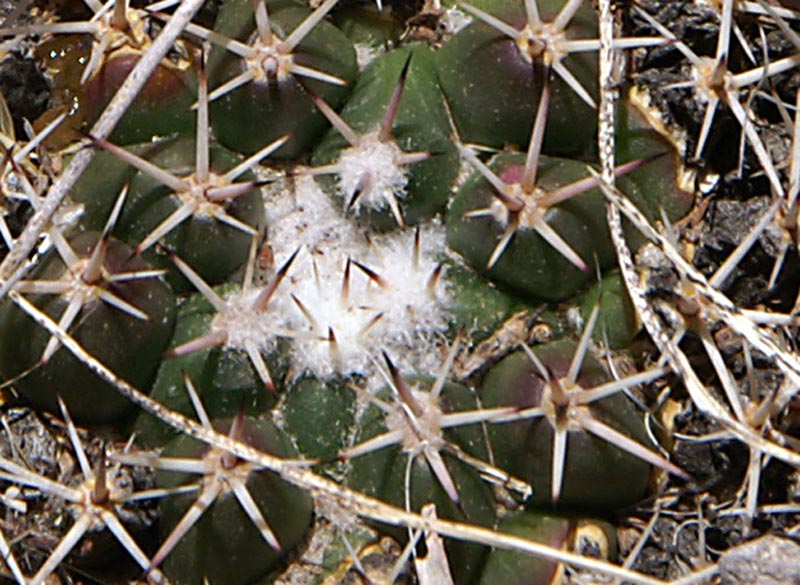 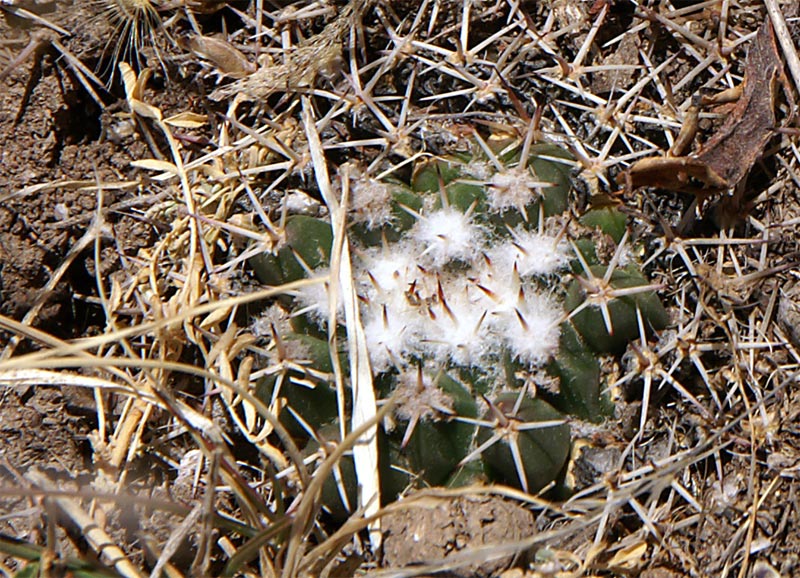 The more I look at these, the less I think that they are Mammillarias, and more likely to be Cory or Thelos. That is based mainly on the shape of the tubercle, but if so then what species?
_________________
Chris43, moderator
| |
|   | | Guest
Guest
 |  Subject: Re: More plants in habitat Subject: Re: More plants in habitat  Wed May 11, 2011 4:06 pm Wed May 11, 2011 4:06 pm | |
| Whatever it is, Chris, it is very pretty. Strange it has no grooves, glands or elongated tubercles. Who knows it could be a new species. |
|   | | woltertenhoeve
Number of posts : 343
Registration date : 2009-10-01
 |  Subject: Re: More plants in habitat Subject: Re: More plants in habitat  Wed May 11, 2011 10:02 pm Wed May 11, 2011 10:02 pm | |
| My guess is that the plants of Chris are young M. wagneriana/M. gummifera. In that region you can find M. gummifera/M.wagneriana (I am not sure what name to attach) at a lot of places, almost always in flat, dry meadow-like land. The range over which these plants grow is very large, from Miguel Auza to the south of Fresnillo (and into the mountains west of Jerez de Garcia Salinas), and also into the Mezquital valley. M. wagneriana was described by Boedeker as coming from San Miguel de Mezquital, Zecatecas Some photos of plants in habitat are shown below (it is just a small selection!). I think that the form that you encounter most often (first photo) conforms reasonably well to the Boedeker description of the shorter, straight spined plant, although Boedeker also mentions a form with longer, tortuous spines. Before 1870, San Miguel de Mezquital was called Villa de las Magdalenas, and in 1935 it changed its name to Miguel Auza (info found on internet, http://www.inafed.gob.mx/work/templates/enciclo/zacatecas/municipios/32029a.htm). Michel Lacoste usually attaches the name M. gummifera to plants from the general region mentioned above. In his field notes he comments as follows on the plants northwest of Jerez de Garcia Salinas, from one and the same location: "ML 595: M. petterssonii aff. (M. obscura or M. wagneriana var. tortulospina?). ML 596: M. gummifera. One can ask whether these plants and the previous ML 595 are really different)". About the plants near Sombrerete (not so far from San Francsico de los Organos), Rogozinski in his 2003 report comments: "M. wagneriana. It looks to us that in this region M. wagneriana and M. heyderi intergrade into each other or grow here side by side. We do not yet have a clear view". All in all, it shows how problematic the identification of plants in nature can be. The first photo shows the type of plants you encounter at a lot of spots in this region (more than 90% of the plants look like these ones), they can grow up to 20 cm diameter and almost always they grow in flat areas.  The following 3 photos are from one and the same location, a flat area at the foot of mountains, south of Fresnillo. The first photo shows two completely different looking plants, yet I think they are one and the same species (see also what Michel Lacoste wrote about his ML 595 and 596). The left one was the rare form. The second and third photo were made several years later at the same location, the left plant is the common one, the right one (middle photo is a close-up) is the exception. These 3 photos show how variable the plants can be. 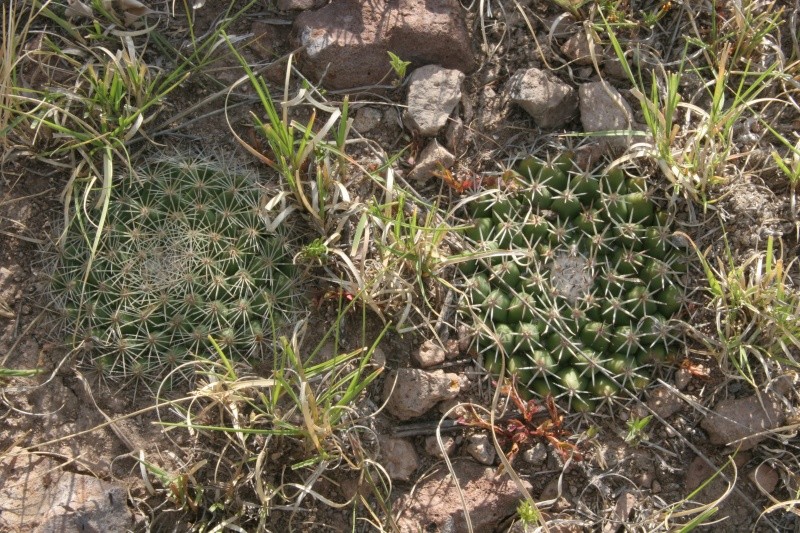 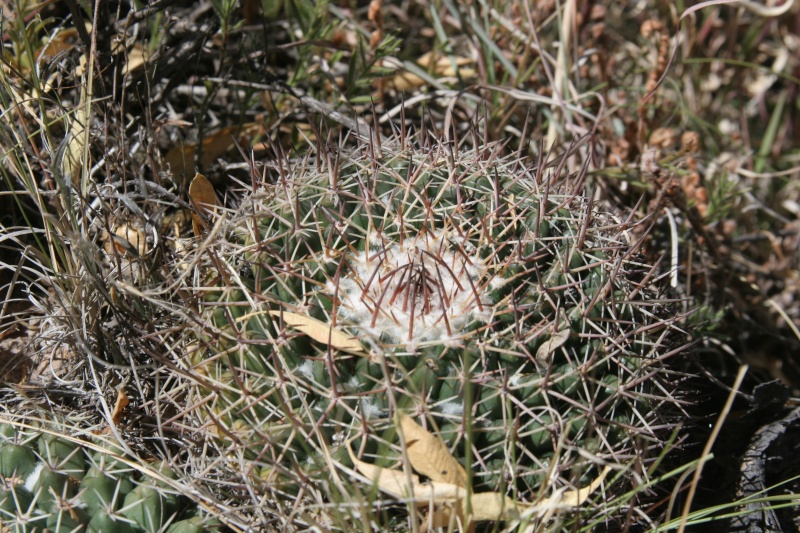 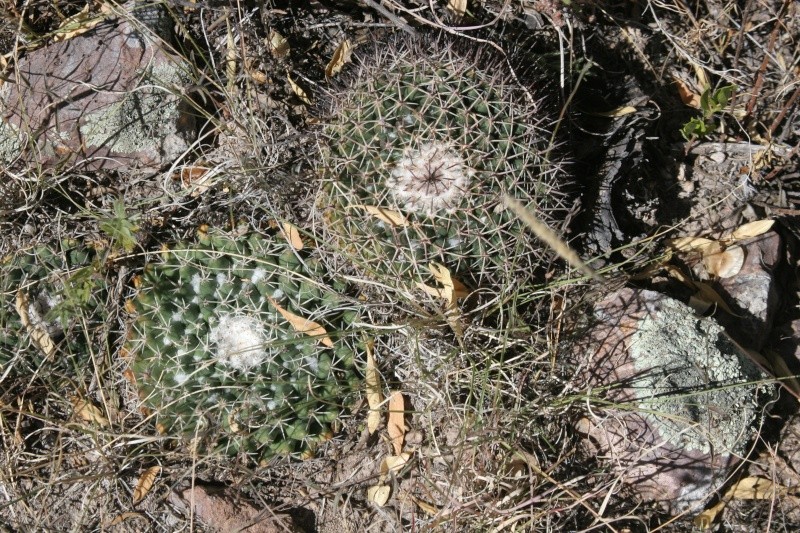 The following photo is of a flowering plant near Sombrerete, in the spring of 2009. It is the most common form in this general region, more than 90% of the plants look like this one and the plants of the first photo: 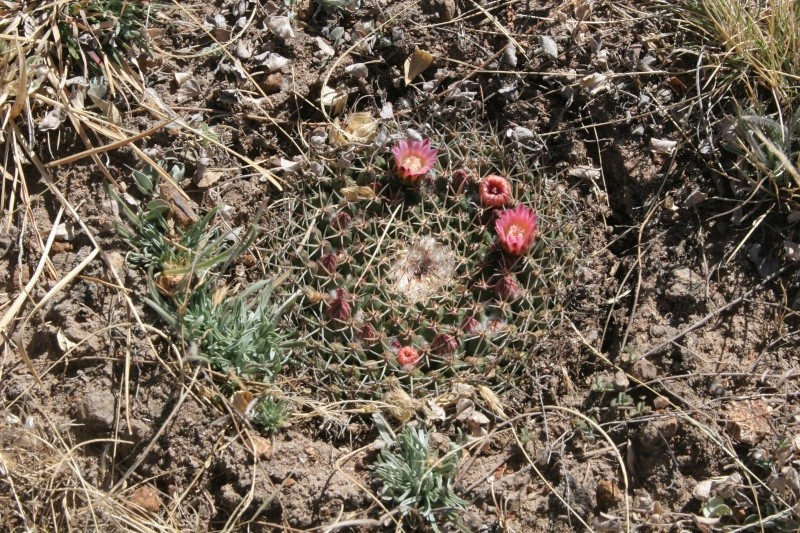 The following photo is of a somewhat different looking plant near San José de la Parilla, between Sombrerete and Durango:  Here are 2 photos from plants on a hill at Boca del Mezquital (north part of the Mezquital valley). It shows the enormous variability of the plants on this hill, and the difficulty I have in ID'ing these plants. Many of the plants were damaged and partially eaten by donkeys!   | |
|   | | Chris43
Moderator


Number of posts : 1872
Age : 81
Location : Chinnor, UK
Registration date : 2008-07-16
 |  Subject: Re: More plants in habitat Subject: Re: More plants in habitat  Thu May 12, 2011 3:01 pm Thu May 12, 2011 3:01 pm | |
| Very close to where I took the photo of these plants, I also found several other plants which perhaps might be related. 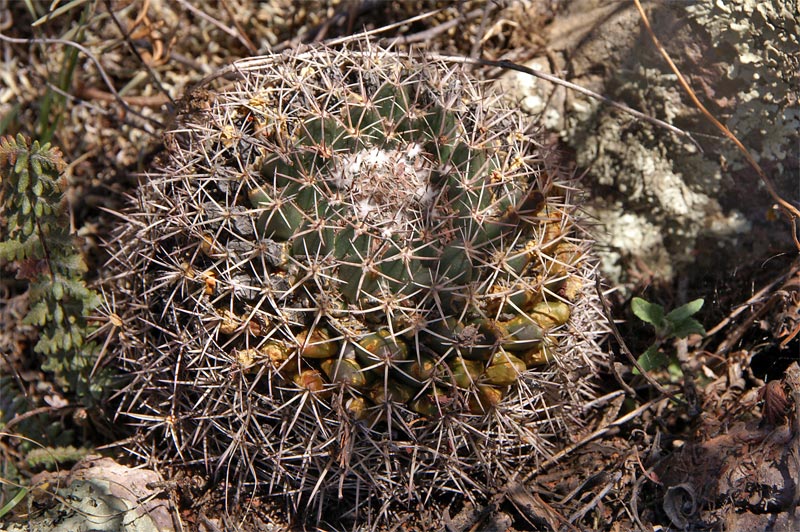   The second and third plants appear to have enough radial spines to match the description of M. gummifera (10-12, with 1-4 central spines), though as you can see there is a clear difference in flower colour between the two, if that is of any significance. The first however, could well be related to the orginal foursome. Maybe just a lower spine count in that form, as we know that variability can be much broader than the formal descriptions allow. This, I believe is definitely M. gummifera, which I saw to the west of Durango on the old road to El Salto. 
_________________
Chris43, moderator
| |
|   | | Guest
Guest
 |  Subject: Re: More plants in habitat Subject: Re: More plants in habitat  Thu May 12, 2011 8:24 pm Thu May 12, 2011 8:24 pm | |
| Well here are a few I took from the area but I am sure non look like the plants shown by Chris. even those later ones uploaded by Chris and Waltertenhoeve. These two were taken from North Sombrerete 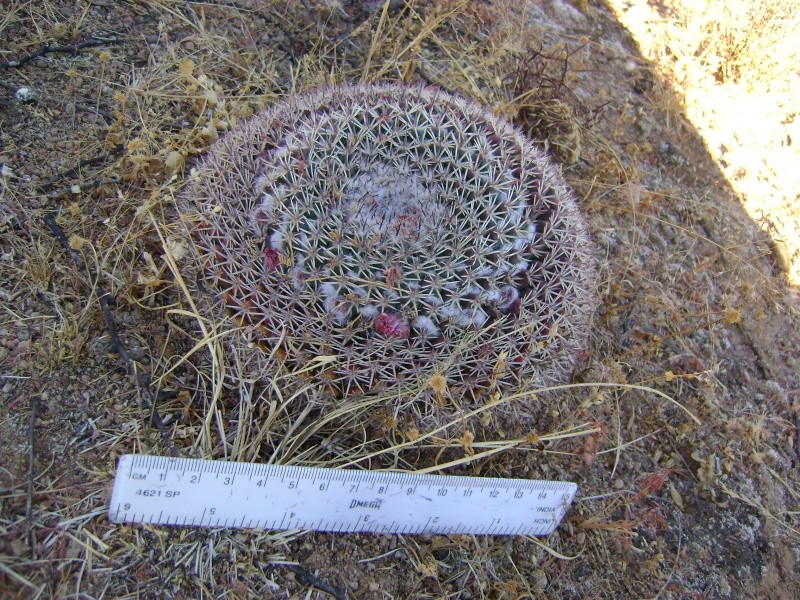 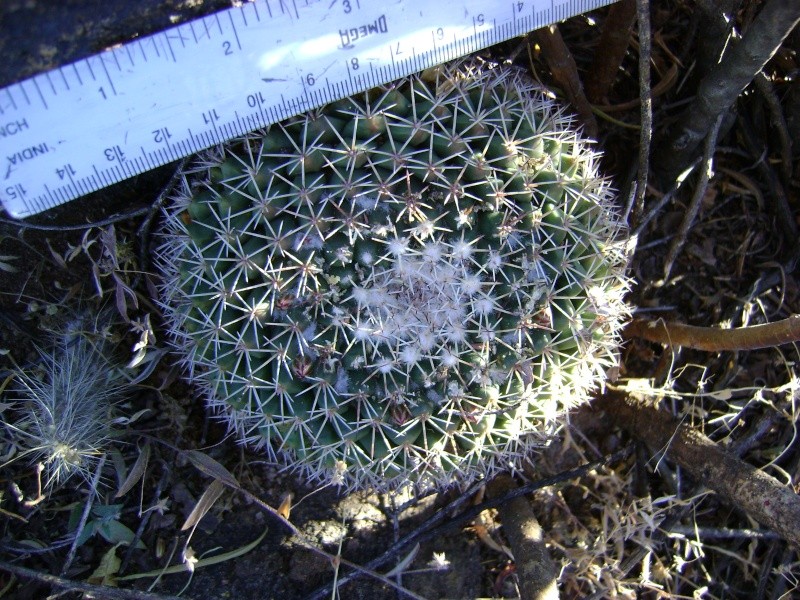 And the following near Organos, Zacatecas at 22°55'N, 102°55'W 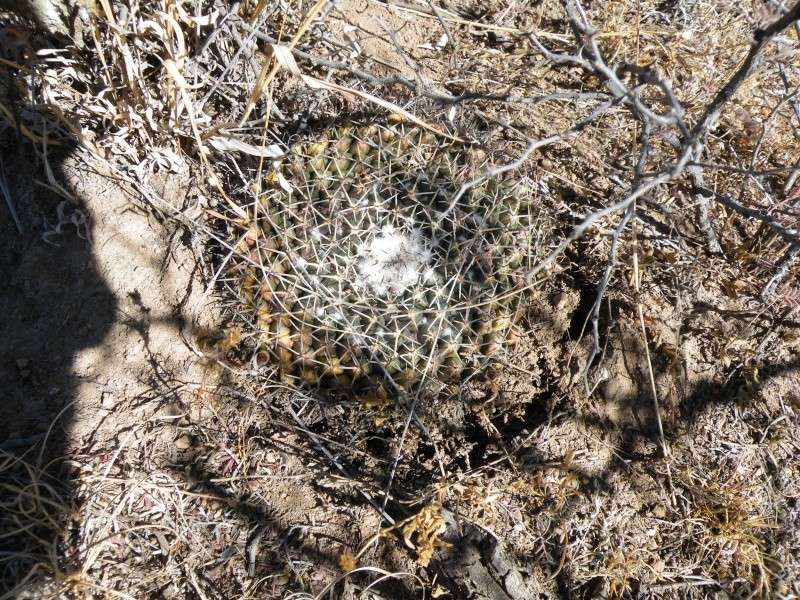 Two from Presa Del Tesoro, Zacatecas 22°49'N, 102°57W   Two from Near Telango, South of Villa Nueve at 22°16'N, 102°52'W 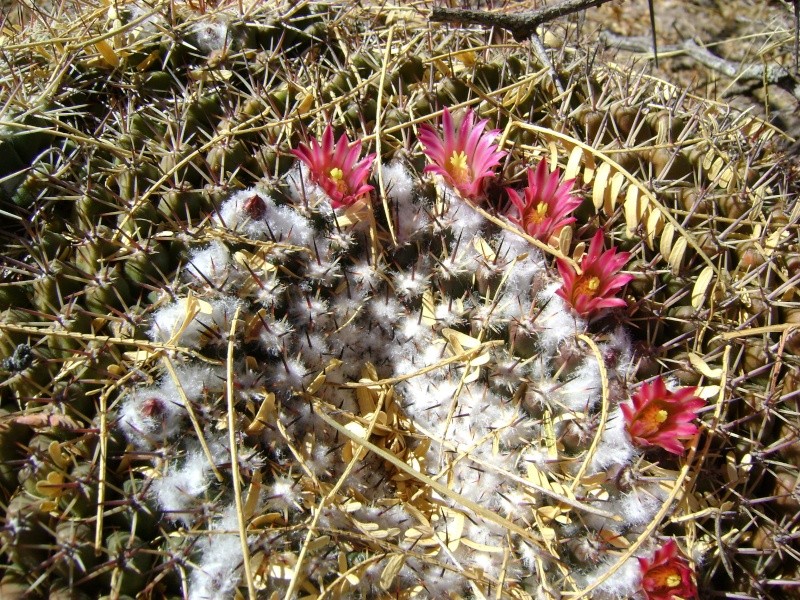  North of Zapoqui, Zacatecas at 22°14'N, 102°50'W  Near Carvillo, Aguascalientes at 21°46N, 102°48'W 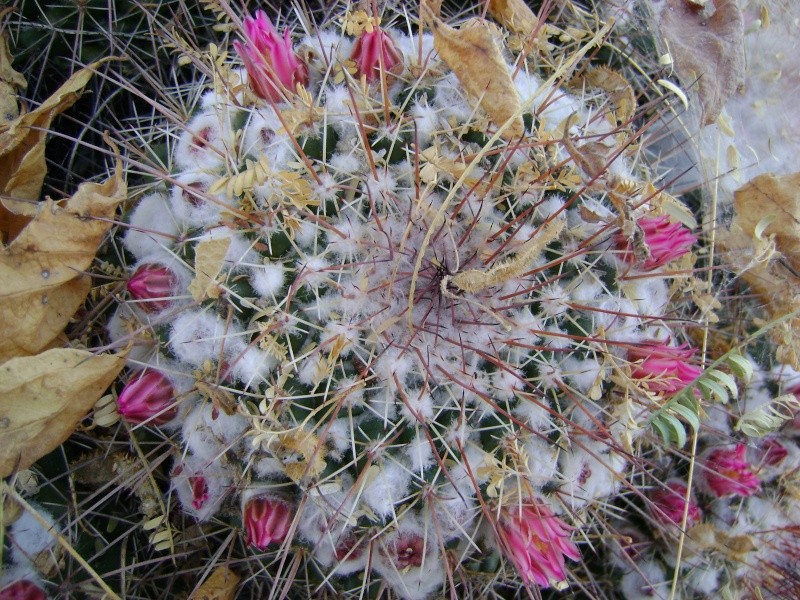 |
|   | | woltertenhoeve
Number of posts : 343
Registration date : 2009-10-01
 |  Subject: Re: More plants in habitat Subject: Re: More plants in habitat  Fri May 13, 2011 8:02 pm Fri May 13, 2011 8:02 pm | |
| The Amante plants north of Sombrerete are quite typical for M. wagneriana/M. gummifera of the general region which I mentioned. They are quite similar to the plants in my first photo and in some of Chris' photos. I took most of the photos of the non-flowering plants in the fall, and then they look quite different from the same plants in the spring. In the fall, the plants are usually swollen because of the summer rains, whereas the plants in the spring are very dehydrated. The Amante plants from Presa del Tesoro fall within the same M. wagneriana/gummifera group, the second photo of the Telango plants is what I consider to be M. petterssonii, just like the plants from the region around Calvillo. In my opinion, there is a gradual transition from one species into the other, from wagneriana into gummifera, from wagneriana into petterssonii, and perhaps even from wagneriana/gummifera into scrippsiana. Some of the plants which I found south of Temo(h)aya, which itself is southwest of Mezquital, seemed to show some similarity with scrippsiana (2nd photo), whereas others were more like wagneriana/gummifera. The 3 photos below are all from the same location south of Temohaya (fall of 2010), it shows how variable the plants can be and how difficult it is to ID them. In between Temohaya and Mezquital, and somewhat north of Mezquital, the plants are more uniform and looked more like wagneriana/gummifera. In the south of Zacatecas (and Jalisco), around San Juan Capistrano, one can find quite typical petterssonii plants, but at other locations in this region there are plants which look quite different from petterssonii (shorter spined). All in all, I find it very, very difficult to put a label on the Mammillarias from this region in Durango - Zacatecas - Jalisco.    | |
|   | | Chris43
Moderator


Number of posts : 1872
Age : 81
Location : Chinnor, UK
Registration date : 2008-07-16
 |  Subject: Re: More plants in habitat Subject: Re: More plants in habitat  Sat May 14, 2011 10:28 am Sat May 14, 2011 10:28 am | |
| I think that your view, Wolter, that there is a gradual transition from Mammillaria heyderi ssp. gummifera towards Mammillaria pettersonii makes a lot of sense. Hunt suggests that wagneriana is just a form of pettersonii, and I think that he seems to be suggesting in effect that none of the intermediate forms are named. Others, Reppenhagen included, name some of these intermediate forms.
I am sure that some of the plants that I found conform very clearly to wagneriana, while others are clearly pettersonii, and others more like those pictured above.
Obviously one can go too far in the direction of ignoring local forms, but equally well, too much fragmentation can obscure the similarities.
After all, if one were to give the single or upper central spine on these plants a high degree of variability in their length, and in the degree of the upwards curve, maybe wagneriana isn't good.
One just has to resist the temptation to put the plants in "boxes" and just enjoy the variation of nature!
_________________
Chris43, moderator
| |
|   | | Sponsored content
 |  Subject: Re: More plants in habitat Subject: Re: More plants in habitat  | |
| |
|   | | | | More plants in habitat |  |
|
Similar topics |  |
|
| | Permissions in this forum: | You cannot reply to topics in this forum
| |
| |
| |
|
